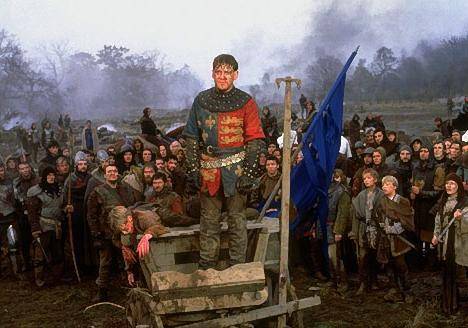Browsing this morning in Sir Nicholas H. Nicolas’ biographical sketches of the Scrope v. Grosvenor deponents, I noticed that Sir Richard Waldegrave (d. 1435), ancestor, via Sir William and Margery (Wentworth) Waldegrave, to many American colonists (including my ancestor Anne [Derehaugh] Stratton), is stated by Nicolas to have fought at the battle of Agincourt (October 1415). I had not previously noted any specific ancestor of mine at Agincourt, though to be sure I had not looked. Given the stirring speech Shakespeare put into Henry V’s mouth about the participants, the memory of the battle, and their posterity, I think this is sort of interesting.
This is not traditionally held as a ‘plum’ by American genealogical enthusiasts, even those with a fascination for military descents. After all, Agincourt was part of a war of aggression by one king against another: it has nothing to do with the reality or myth of the birth of democracy, which, for example, draws Americans to the self-interested baronial rebels of the Magna Carta. Nor does it have a place in English aristocratic sentiment like that held by the original Norman Conquest, or even the Crusades. For all Shakespeare’s glorification, the English in France were responsible for burning Joan of Arc — now a saint — and lost the whole occupation scarcely thirty years later, contributing to the bitterness of the Wars of the Roses.
Therefore there is no compilation of ancestors at Agincourt targeted at an American audience. But who else, among Americans’ commonly-studied ancestors (i.e. those of known seventeenth-century immigrants), was at Agincourt? Nicolas, in his 1832 book on Agincourt, prints a manuscript purporting to be a copy of a list of the knights and men-at-arms (‘lances’) present at the battle: there are some nine hundred names in all, listed in the retinues of about 70 peers, knights, or other leaders. Sir Richard Waldegrave is in the retinue of Sir William Bourchier, with two other knights and 21 ‘lances’ or men-at-arms.
I am aware that Nicolas’ list has been discussed and impugned as inauthentic, though it is probably a good deal less fantastical than, say, the ‘Battle Abbey Roll’ for Hastings. The great mass of undifferentiated names in this list, arranged in specific retinues, had to come from somewhere, and even if not contemporary probably represented a good-faith effort to reconstitute a list, perhaps a generation or two after the battle? I would like to find a good critical discussion of this and other information presented by Nicolas.
On a separate page I have presented a condensed version of Nicolas’ list. Here I have transcribed only the names of the head of each retinue, and the names of any knights appearing in a retinue, on the grounds that these will be far easier to positively identify than an undistinguished name. Someone with a Complete Peerage on the shelf can fill in the peers’ identities right off. But how many of those listed as knights (marked ‘chevalier’ or ‘monsieur’) or esquires are readily recognizable? And how many of all of them (peers, knights, esquires and regular folks) are known to have modern descendants? For Americans, how many of the standard set of colonial-era ‘gateways’ have ancestors on this list? In my own ancestry I only note that I descend also (via William Wentworth) from Sir Thomas Gresley, who is mentioned in Nicolas’ list as leading a retinue, but in a curious way which suggests that he was not present at the battle. Nevertheless, accepting him as a participant, I present on another page my two descents from knights at Agincourt.
Source: Sir Nicholas Harris Nicolas, History of the Battle of Agincourt and of the expedition of Henry the Fifth into France in 1415, to which is added the roll of the men at arms in the English army, 2d ed. (London, 1832), pp. 333-363.


One Trackback/Pingback
[…] with an ancestor at the Battle of Agincourt should know this song. There is an excellent modern transcription and brand-new musicological […]
Post a Comment